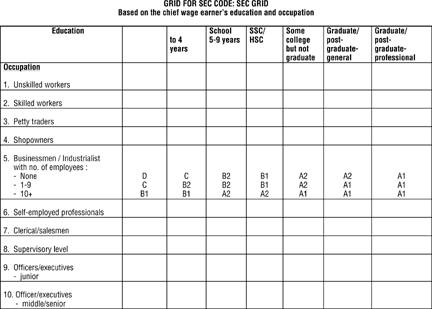Highly classified
Editor’s note: R. Ashok is general manager at India-based ORG-MARG Research Pvt. Ltd.
India is a diverse and complex country. There are as many as 14 officially recognized languages and several more dialects. The population of a billion sees followers of five major religions. The country is divided politically into 25 states, each with its own government, and there are three or four sociocultural regions in each state.
All this means that the marketer of a product cannot think in terms of a pan-Indian consumer but has to be very careful about which segments he is addressing. The research industry naturally has to keep pace with these needs and has had to constantly update itself on techniques for gathering information, for analyzing data, and significantly for segmenting consumers.
This article is about the socio-economic classification system in use in India today, which was developed nearly a decade ago.
Market research in India has moved away from using income to define target audiences and has started using socio-economic classification (SEC) instead. The Indian SEC system is a classification based on the combination of the education and the occupation of the chief wage earner of the household (see below). There are eight levels - from A1 to E2. The SEC system was first developed in India through the efforts of the Market Research Society of India (MRSI), and was then validated by a series of efforts, including a paper by this author in 1992.
 |
Less than 15 percent of the population falls under SEC A1. The correlation between SEC and income is high but far from perfect.
The basic reasons for developing a SEC system were the following:
1. Income can discriminate between consumers and non-consumers for certain products, but not for others.
2. Income is not stable over time whereas SEC is, i.e., the cut-offs of high and low income will vary quite rapidly over time.
3. Income is often understated.
The last has been proved by large-scale studies that compared household expenses with claimed income. Over 80 percent of upper income respondents were found to have regular monthly expenses well in excess of their stated monthly household income (MHI), and this proportion was not much lower among lower income respondents too.
The second of the three reasons is also beyond dispute. Salary levels in India have undergone a huge change in the 1990s; annual incomes of 1 million-plus rupees are earned by thousands of families today, but were the privilege of the very rich a decade ago.
This article examines the first reason stated in the context of a few product categories. The method used is that of a selectivity index, which compares the extent to which target audience definitions using surrogate variables SEC and monthly household income (MHI) match with the actual target audience as measured by very large-scale studies - specifically the Indian Readership Survey.
To understand the index, let us consider the following situation: a manufacturer of color TVs would like to target current owners of black-and-white TV sets. He therefore defines such people in terms of a surrogate variable such as MHI and prepares a media plan under the assumption that by covering the persons defined by the surrogate variable, he is also covering the actual market for his product.
The index compares the efficiency of SEC and MHI in performing this role of surrogate variable.
The actual calculation is as below:
 |
The first quadrant represents the overlap between the actual target audience and the segment defined by the surrogate variable. The second quadrant represents the portion of the target audience missed out by the surrogate variable. The third quadrant is the segment that is neither part of the target audience nor defined by the surrogate variable, and is therefore of no interest to us. The fourth quadrant is the segment defined by the surrogate variable but not part of the target audience, and is hence the wastage.
The selectivity index S is = Q1*100 / (Q1+Q2+Q4)
A high selectivity index (maximum possible = 100) indicates that the variable is useful for targeting. When the index is low, it could be either because of high wastage, or because of high “missing out.” High wastage indicates the need for further refinement of the variable, while high missing out means that the marketer is working with an imperfect understanding of the product penetration, which is definitely worse than a high wastage score.
The results summarized in the chart clearly indicate that SEC does not perform worse than MHI for any product category and actually performs better for some.
SEC is on the whole better for household goods, especially for premium category products. Not surprisingly, SEC performs better for English newspapers. The parity on financial dailies is a natural consequence of the fact that India’s investing and entrepreneurial community is not necessarily the most educated. The most educated people in India are typically in government or private employment.
Some of the categories show a high wastage. This strongly indicates that neither SEC not MHI is able to accurately fine-tune the target definition. Clearly there is a need for a new variable to be developed. Merely combining SEC and MHI will not serve the purpose. One option being pursued actively is monthly household expenses, which seems to function adequately for fast-moving goods and leisure products.
Further refinement
Market research in India has been evolving rapidly to tackle the increasing needs of marketers operating in a complex environment. One of the key evolutions was the development of an socio-economic system of classifying consumers around a decade ago. While SEC is an improvement on income, data from large-scale studies show that further refinement is now called for.
One possible solution is to introduce further levels in the SEC system. This is being done by combining SEC with household expenses to see if a combined system yields better results. The appropriate questions are now being put on to large-scale surveys. The results are expected by early January.
